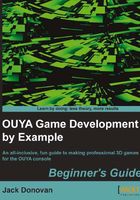
Time for action – heading
- Action 1
- Action 2
- Action 3
Instructions often need some extra explanation so that they make sense, so they are followed with:
What just happened?
This heading explains the working of tasks or instructions that you have just completed.
You will also find some other learning aids in the book, including:
Pop quiz – heading
These are short multiple-choice questions intended to help you test your own understanding.
Have a go hero – heading
These practical challenges give you ideas for experimenting with what you have learned.
You will also find a number of styles of text that distinguish between different kinds of information. Here are some examples of these styles, and an explanation of their meaning.
Code words in text, database table names, folder names, filenames, file extensions, pathnames, dummy URLs, user input, and Twitter handles are shown as follows: "Open your RollingMarble Unity project and double-click on the scene that has your level in it."
A block of code is set as follows:
void Update()
{
if(Input.GetKeyDown(KeyCode.Return))
{
print(ChangeColor(Color.green));
}
else if(Input.GetKeyDown(KeyCode.Space))
{
print(ChangeColor(Color.blue));
}
}
Any command-line input or output is written as follows:
source ~/.bash_profile
New terms and important words are shown in bold. Words that you see on the screen, in menus or dialog boxes for example, appear in the text like this: "Click on Sign up on the following page and follow the instructions to create your OUYA developer account."